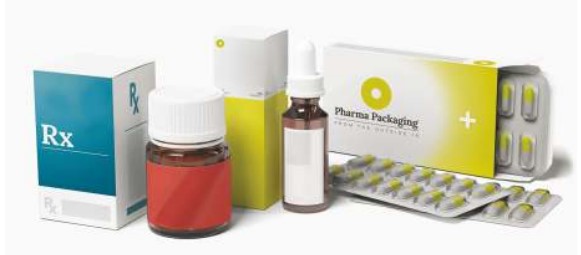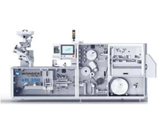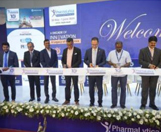Evolving Pharma Labeling
Embracing Digital Innovations and Sustainable Practices Amidst Regulatory Pressures

Pharma labeling trends are evolving rapidly to address regulatory changes, technological advancements, and the increasing demand for patient-centric approaches. Key trends in this area include digital labeling, e-labeling, smart labels, custom labels, and a strong focus on regulatory compliance, eco-friendly materials, sustainability, etc. These innovations make it easier for healthcare professionals and patients to instantly access detailed information, such as dosage instructions, potential side effects, and interactive content. In his interview with Pharma Machines & Technology, Dr. Avinash Talwar further highlights that pharmaceutical labeling is a critical component of the industry, as it involves creating and presenting vital information on drug products through labeling. At the same time, the pharmaceutical industry faces increasing pressure to adopt more environmentally friendly labeling and packaging practices.
 Avinash Kumar Talwar is currently the Vice President of Global Sourcing PM & MRO at Global Supply Chain Management at Dr. Reddy’s Laboratories Ltd.
Avinash Kumar Talwar is currently the Vice President of Global Sourcing PM & MRO at Global Supply Chain Management at Dr. Reddy’s Laboratories Ltd.
With a rich experience of over 3 decades, Avinash has successfully planned, sourced, managed, and executed supply chain operations. His deep understanding of standard processes & technology and his proven leadership have enabled him to establish key supply chain processes in the most challenging environments. This has consistently led to superior operational and financial results. His comprehensive wisdom, gained through working closely with top management and prestigious consulting firms, sets him apart. Avinash’s belief in system-driven processes and driven individuals is a cornerstone of his leadership style. He possesses strong interpersonal skills, excellent attention to detail, and brilliant analytical skills. He is a Post Graduate gold medallist from IIP & Executive Alumni of ISB.
Avinash Kumar has a total of 30+ Years of experience. He has diverse experience in several areas, including procurement, vendor management and development, vendor audits, inventory control, packaging development, process re-engineering, cost excellence, Innovation, and digitalization. In the past, he was associated with Ranbaxy Ltd, Nestor Pharma, Max Pharma, and Sytopic Labs Pvt. Ltd. Dr Anivash Kumar has contributed various articles on Packaging, Labeling, Supply Chain, etc. in top publications and has received numerous awards in various summits and award ceremonies.
1) What do you identify as the most impactful trend currently shaping the pharmaceutical labeling market, and how do you foresee it influencing industry dynamics in the near future?
The pharmaceutical business is under increasing pressure to implement more environmentally friendly packaging practices. Environmental concerns, customer demand, and regulatory restrictions contribute to this trend. As a result, many pharmaceutical businesses are utilizing recycled and recyclable materials and biodegradable and compostable packaging. In my opinion, the trend that is having the most significant influence on the label industry right now is sustainability. Adopting this will undoubtedly be difficult for the industry because of several factors, including competition in the market, pricing pressure, and a lack of government support in the form of incentives while using.
2) Cryogenic labeling is gaining traction in the pharma industry. Can you discuss the challenges and advancements associated with cryogenic labeling solutions, and how is your company addressing the growing demand for such labels?
Cryogenic labels are designed and produced to work and perform properly at temperatures below freezing. Typically, labels are designed with a particular cryogenic storage stage in mind. Using labels that can survive storage temperatures, temperature fluctuations, and operations is critical. Cryogenic temperatures can range from -90°C to -70°C, with drops as low as -135°C to -190°C in the liquid nitrogen vapour phase, up to thaw temperatures.
Numerous challenges come with cryogenic temperatures, such as labels being unable to adhere to frost and the inks smearing or scratching off the label. Additionally, labeling at room temperature and immediately placing it into cryogenic temperatures can cause the label to flag. After numerous trials and tests, we identified neck hanger labels, overlap labels, and slit labels are the ideal solutions for this issue.
3) Counterfeiting protection is a critical concern in the pharmaceutical sector. How is your company innovating in developing label solutions to enhance security features and protect pharmaceutical products from counterfeiters?
Technologies such as tamper-evident packaging, track and trace systems like RFID tags and 2D barcodes, advanced data analytics for supply chain integrity, and serialization, which assigns a unique identifier to each drug container, are used to prevent drug counterfeiting. We use covert and overt features like micro text, holograms, specific varnishes like coin reactive print, and printing of variable information, which can be seen by the naked eye using advanced instruments.
In addition to the labeling solutions, we are almost ready to develop and roll out a platform for customers to check the genuineness of the product using their phones.
4) The use of recyclable and biodegradable label products is rising. Could you share insights into the sustainable labeling solutions your company offers and the impact of such eco-friendly initiatives on the pharma label market?
The pharmaceutical market is dominated by pressure-sensitive labels, which come with a release liner made of PET to suit the high-speed machine requirements. As a step towards sustainability, we replaced the release lining with a biodegradable solution. These labels are environmentally friendly and do not affect the label’s performance.
Specific labels make recycling bottles impossible, even in costly washers, so it is best to avoid them if you want to be ecologically conscious. The raw materials available in the market for label production are recyclable, making them environmentally friendly. These green labels have a face material approved by the Forest Stewardship Council (FSC), and the inks and adhesive are water-based. Also, we are researching on using liner-less labels that come without release liners, which would reduce waste.
5) What role do technological advancements, such as digital printing and smart labels, play in shaping the future of the pharma label market, particularly concerning customization and anti-counterfeiting measures?
A digital print label is a form of label printing technology that uses digital printing techniques. It includes printing labels directly from a computer, eliminating the need for traditional printing plates or cylinders. This technology offers greater flexibility, personalization, and faster production times than traditional label printing methods. Digital printing is also now available for printing on Aluminium foils.
The current outlook for the digital print label market is optimistic. The demand for digital print labels is fast increasing in various industries, including food and beverage, pharmaceuticals, personal care, and retail. Several factors contribute to this development, including increased product modification and personalization requirements, greater demand for product traceability and anti-counterfeiting measures, and the necessity for shorter print runs.
Furthermore, developments in digital printing technology have reduced costs and increased efficiency, propelling market expansion. Digital print labels have several advantages, including shorter setup times, lower production costs for small runs, and the ability to print variable data, such as barcodes and QR codes, which are critical for supply chain management and tracking.
The future of the digital print label business appears bright. The market is predicted to continue developing at a rapid pace. The increasing implementation of digital print labels across numerous sectors is expected to push market expansion even further. E-commerce and the demand for sustainable packaging solutions are also predicted to drive market growth.
Furthermore, technical developments, such as higher print quality and quicker printing rates, are expected to drive demand for digital print labels. As businesses aim to improve their brand image and increase efficiency in labeling and packaging operations, the digital print label market is expected to expand significantly in the coming years.
6) Can you elaborate on the role of smart labeling technologies such as RFID and NFC in enhancing supply chain visibility, inventory management, and patient engagement within the pharmaceutical industry, and how do you anticipate their adoption evolving in the coming years?
Smart labels have emerged as a disruptive force across various sectors with rapidly changing technology and customer needs. These intelligent labels, which incorporate modern technology such as Radio-Frequency Identification (RFID), near-Field Communication (NFC), and sensors, are transforming traditional packaging and supply chain procedures. The smart label industry is seeing unprecedented expansion, driven by the growing need for improved traceability, sustainability, and customer interaction.
One of the primary reasons for the growth in demand for smart labels is their capacity to give real-time information and data across the supply chain. RFID and NFC technology in these labels allow for seamless monitoring of items from manufacturing facilities to distribution hubs and, finally, retail shelves. This increased visibility not only lowers the risk of mistakes and losses, but also enables organizations to optimize their logistics and inventory management, resulting in considerable cost savings.
The capacity of smart labels to deliver real-time data and information across the supply chain is one of the main factors contributing to their increase in demand. The products can be easily tracked from production plants to distribution hubs and, ultimately, to store shelves thanks to RFID and NFC technologies included in these labels. Increased visibility lowers the possibility of mistakes and losses while enabling companies to manage their inventories and transportation more effectively, saving a tonne of money.
In addition, smart labels are essential in tackling the rising issue of product authenticity and counterfeiting. These labels have built-in anti-counterfeiting mechanisms so manufacturers can guarantee the authenticity of their goods. This is especially important for sectors like pharmaceuticals, where fake medications seriously threaten the public’s health. Smart labels promote trust and brand loyalty by allowing customers to use their smartphones to confirm a product’s authenticity.
7) As the pharma industry continues to evolve, what emerging trends do you foresee shaping the future of the pharma label market, and how is your company positioned to capitalize on these opportunities?
Pharmaceutical exports from India to the global market will reach $28 bn, an increase of 10% in FY 24. The US contributes 31% of exports. The Indian Pharmaceutical industry is the third largest by volume and 13th by value globally, producing more than 60,000 generic drugs across 60 therapeutic categories.
Due to the industry’s growing demand, new developments and trends in pharmaceutical labeling are emerging. Packaging must provide a better guarantee against product damage or contamination to increase the integrity of drug storage and shipment.
Self-medication has already increased in number. As this expands over the next years, clear and timely labels will be more necessary for goods.
According to a recent estimate, the pharmaceutical business in Europe experienced the second-largest revenue loss, totaling 16.5 billion EUR (18.2 billion USD), due to counterfeit items on the market.
Precise estimates of lost sales and revenue are difficult to determine, but the World Health Organization believes that counterfeiting costs the worldwide pharmaceutical business $75 billion USD annually. According to a PricewaterhouseCoopers analysis published in 2017, the counterfeit medication sector generates between 163 and 217 billion USD per year, making it one of the most profitable forms of illegally copied commodities.
The second significant cost is patient non-adherence, projected to be between 100 billion to 290 billion USD in the United States, 1.25 billion EUR in Europe, and around 7 billion AUD in Australia. Furthermore, pharmaceutical non-adherence accounts for 10% of hospitalizations in older persons, with the average patient requiring three additional medical visits per year, resulting in a $2,000 increase in treatment expenses per year.
Naturally, pharmaceutical businesses seek answers to the costly challenges of counterfeiting and non-compliance. Future-proofing label technology might be the key to reinvesting losses in packaging and potentially turning profits.
Pharma IQ, the organizer of the Pharmaceutical and Labels Summit in Zurich, has identified the top emerging technologies that might bring much-needed change to the pharmaceutical industry. The list includes temperature indicator technology, NFC technology, text-to-voice functionality, counting and light-up packaging, unit dosage, and fingerprint authentication.
Articles
By Rameshwar Verma
An Interview with
President Maurizio Marchesini
Embracing Digital Innovations and Sustainable Practices Amidst Regulatory Pressures
An Interview with
Avinash Kumar Talwar







